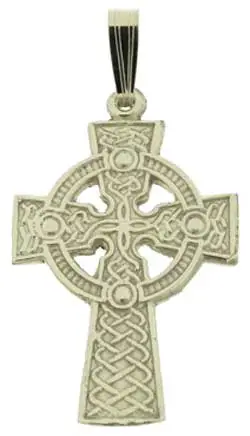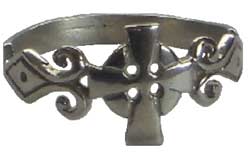Celtic Cross jewelry is rich in symbolism dating back more than 1500 years to the Ireland of the druids and early Christianity.
What that symbolism represents is open to interpretation and can vary widely depending on the views of the individual.
One of the more commonly held theories is that the Celtic Cross was created by St Patrick as he tried to convert the druids and their followers to Christianity. Legend has it that Patrick thought it would be easier to communicate with potential converts if he could reach out to their culture and adapt it to his own purposes.

With this in mind he’s said to have been intrigued by the way the Celts used a circle as part of their religious rituals. The circle may have represented the sun, which was recognised as a life-giving force.
The Celts may also have seen the circle as a symbol of eternity as it had no beginning and no end.
The idea of eternity and a life-giving force, with the Christian God replacing the pagan sun god, appealed to St Patrick and he is said to have taken the circle and placed it behind the cross, the great symbol of the Christian faith.
In this way he united to Celtic and Christian culture making it easier to convert the druids and their followers. It’s also been said that by placing the cross above the circle, St Patrick was emphasising the triumph of Christianity over paganism and its sun god.
It should be pointed out that there is no documentary evidence to back up this theory but it has been handed down through oral tradition and is still widely held today.
Other theories suggest that versions of the Celtic Cross were already in use in Ireland long before Patrick arrived and he simply adopted it.
It is thought that the four points of the cross represented the four elements of earth, fire, air and water in pre-Christian pagan Ireland. Another possibility is that the points represented north, south, east and west.
A version of the cross was used in jewelry and coins as early as the Bronze Age. Back then it was known as a sun cross.
The sun cross was popular in several ancient civilisations and there are pins and pendants dating back as far as the 2nd millennium BC on display at the Swiss National Museum.
In truth, scholars find it extremely difficult to interpret the exact original meaning of the cross. There are a number of theories and folklores but none can be proven.
There is no doubt, however, that St Patrick helped spread Christianity throughout Ireland in the 5th century and the Celtic Cross did become a symbol of the new faith and its dominance.

The Celtic Revival in 19th century Ireland gave the Celtic cross a new lease of life and some new meanings. It came to be the inspiration for numerous pieces or jewelry and featured on bracelets, necklaces and brooches.
This was a time when Ireland was seeking independence from Britain and the Celtic Cross came to be seen as a symbol of Irish nationalism as well as Christianity. Celtic cross jewelry became more widespread during the 20th century. It is now more popular than ever and to be found all across the world.
Celtic cross symbols can now be found on all kinds of products from T-shirts to beer glasses and coffee cups. It’s also popular as a tattoo.
It remains a Christian symbol but, ironically perhaps, it is often worn by people who want to honour their Celtic heritage, particularly in the United States.
Some ancient Celtic crosses carry inscriptions in the ancient Irish form of writing, ogham.